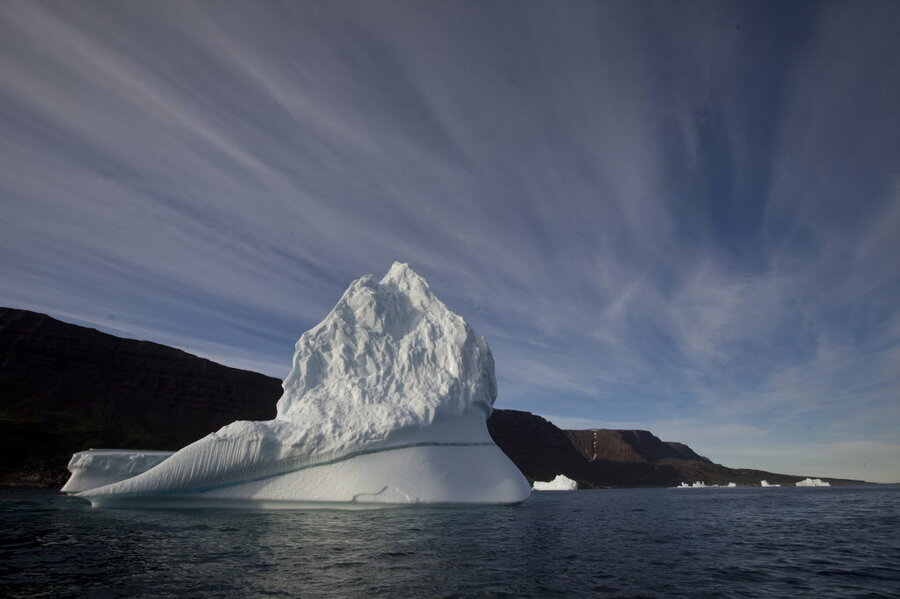Arctic ice melt could cost an extra $60 trillion, say researchers
Loading...
The oil and gas industries have in recent years forecasted profits from easier access to resource fields in the melting Arctic. Northern states have welcomed the trade routes that are emerging from the thick ice’s melt. But those possible boons pale in comparison to the costs that methane emissions from the melting ice will have on the global economy, scientists have found.
The price tag? $60 trillion – or about the size of the entire global economy in 2012 – according to new research that modeled the economic toll that methane gases seeping out of the Arctic will take on the world.
“It's not just bad news for the polar bear,” said Gail Whiteman, a researcher at Erasmus University in the Netherlands and a coauthor on the paper, published in Nature. “It’s a global economic time bomb."
The Arctic is thought to contain about 30 percent of the world's undiscovered gas, as well as about 13 percent of its untapped oil. Those economic opportunities have provided major incentives for investment in Arctic oil and gas fields. Lloyd's of London, an insurance market, has projected that investment in the region could reach $100 billion within 10 years.
At the same time, thawing ice has also cleared a route for vessels there during the summer. Arctic shipping is expected to see about 40 million tons a year in 2050.
But those projected figures do not present a full picture of the economic effects of melting in the Arctic, the authors said.
The Arctic ice stores roughly 50 billion tons of methane, a concentrated gas some 20 times more powerful than carbon dioxide. Over the past few years, scientists have observed the gas pluming from the region’s thawing ice. That raised the question: even as profits are hauled in from shipping and drilling in the Arctic, could that methane gas be waiting to undo all those gains? Could the toll of that released gas far outweigh the rewards of melting Arctic’s ice?
Researchers used what is called the PAGE09 model to assess a broad range of risks arising from methane gas release. Their work is built on the 2006 Stern Review on the Economics of Climate Change’s model, which judged the economic effect of extra greenhouse-gas emissions on such factors as sea level rise, temperature, and extreme weather risk. That model found that, as a result of global warming, the world would incur a total cost of $450 trillion by the end of the century.
But seven years ago there was too little research on methane gas in the Arctic to include in the model its influence on the global economy, Dr. Whiteman said. So this time, scientists modeled a 10-year release of the 50-billion-ton methane bubble between 2015 and 2025 and showed the effects of that decade-long burst until 2200. The model was based on the current rate of greenhouse emissions.
The team found that methane release from just the melting permafrost beneath the East Siberian Sea would accelerate the rise in temperatures to 3.6 degrees Fahrenheit above preindustrial levels to 2030. That increase in temperatures would cost the world some $60 trillion – a sum almost as large as the size of the entire global economy last year, totaled at about $70 trillion. It is also an added cost of about 15 percent to the already $450 million in damages that the Stern model had found in 2006.
“Without question there are some gains for some industries and some countries – but that doesn’t take into account climate change’s negative impact throughout the entire world,” said Whiteman.
That $60 trillion sum is a mean number based on the estimated – but still unknown – amount of methane in the Arctic. That puts the lower and upper boundaries of the total cost at $10 trillion and $220 trillion. The model was also based on a 10-year burst of methane beginning in 2015, but when and over what length of time methane seepage might occur is still unknown.
The developing world will be saddled with about 80 percent of the cost: Countries there are poorly insulated from the toll that climate change can take on public health, agriculture, and infrastructure, and would end up footing the bill, Whiteman said.
“Those places are climate vulnerable and will pick up the price tag,” she said.
Researchers also modeled the damage at a lower rate of greenhouse-gas emissions, with a 50 percent chance of keeping global temperatures below the expected 3.6-degree increase from preindustrial levels. Under that model, the temperature increase and its attached price tag would come at 2040, buying five years' time.
“It's a when, not an if,” said Peter Wadhams, a professor of ocean physics at the University of Cambridge and a coauthor on the study, noting that preventing methane leakage would mean lowering CO2 levels to a point that would freeze the melted ice again. “We don’t have a good way of stopping this process. All we can do is find ways to minimize the impact on human life.”
Still, the situation is not hopeless, the authors said. Abating global warming buys time for intensive geo-engineering research into strategies for dealing with methane release, noted Dr. Wadhams.
"It's too expensive not to do anything about global warming," he said.
In collaboration with other researchers, the team is next planning to model the broader effects of melting in the entire Arctic. Those effects include ocean acidification, as well as altered ocean and atmospheric circulation. The future model will also deepen an understanding of how methane gas will affect the world, pinpointing the regions and countries that will bear the brunt of its costs and the specific tolls that it will take on those economies.








